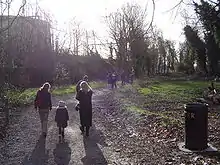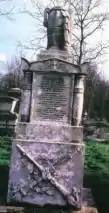| Tower Hamlets Cemetery Park | |
|---|---|
.jpg.webp) Monuments in Tower Hamlets Cemetery | |
| Details | |
| Established | 1841 |
| Location | |
| Country | England |
| Coordinates | 51°31′24″N 0°01′36″W / 51.5232°N 0.0267°W |
| Type | Public |
| Owned by | Tower Hamlets London Borough Council |
| Size | 10.93 hectares (27.0 acres)[1] |
| No. of interments | 350,000 |
| Website | fothcp |
| Find a Grave | Tower Hamlets Cemetery Park |
Tower Hamlets Cemetery Park is a local nature reserve and historic cemetery[2] in the London Borough of Tower Hamlets within the East End of London. It is regarded as one of the seven great cemeteries of the Victorian era, the "Magnificent Seven", instigated because the normal (until that time) church burial plots had become overcrowded.
The cemetery opened in 1841 and closed for burials in 1966. Tower Hamlets Cemetery Park today encompasses the original historic cemetery, bounded by historic walls, and additional pockets of land including "Scrapyard Meadow" and the Ackroyd Drive Greenlink. The overall site is today celebrated as Site of Metropolitan Importance for Nature and Conservation and an award-winning local nature reserve, including recognitions from Green Flag, London in Bloom and Tower Hamlets in Bloom.
It was originally named The City of London and Tower Hamlets Cemetery but was called Bow Cemetery by locals for its Bow, London, locality. The cemetery pre-dates the creation of the modern Borough of Tower Hamlets in 1965, and instead takes its name from the original, older and somewhat larger, Tower Hamlets (or Tower division) – from which the modern borough also takes its name. The historic parish boundary which defines the Mile End and Bromley-by-Bow areas runs north to south through the park, with Mile End to the west and Bromley-by-Bow to the east.
Location
The Main Gate is on Southern Grove (on the crossing with Hamlets Way). There are also smaller pedestrian gates along Hamlets Way and Cantrell Road. The nearest tube stations are Mile End, Bow Road, and Bow Church.
The site has been managed by the Friends of Tower Hamlets Cemetery Park, a registered charity in the UK founded in 1990. The Friends are headquartered at the Cemetery Park Lodge and also conduct a range of activities from the Soanes Centre. Both buildings are located in the north-west corner of the Cemetery Park.
History
Before the Victorian era, all of London's dead were buried in small urban churchyards, which became so overcrowded and so close to where people lived, worked, and worshipped that they were causing disease and ground water contamination.
An Act of Parliament was passed which allowed joint-stock companies to purchase land and set up large cemeteries outside the boundaries of the City of London. There were seven great cemeteries (the "Magnificent Seven") laid out about the same time (1832–41). Highgate Cemetery is the most well known; the others are Nunhead, West Norwood, Kensal Green, Brompton, Abney Park.
The City of London and Tower Hamlets Cemetery Company was made up of eleven wealthy directors whose occupations reflected the industries of the day: corn merchant, merchant ship broker and ship owner, timber merchant, and Lord Mayor of the City of London. The company bought 27 acres (109,265 m2) of land and the cemetery was divided into a consecrated part for Anglican burials and an unconsecrated part for all other denominations.
Tower Hamlets Cemetery was formally consecrated by the Bishop of London Charles James Blomfield on Saturday 4 September 1841 prior to being opened for burials. The cemetery was consecrated in the morning; the first burial took place in the afternoon.[3]

Tower Hamlets Cemetery was very popular with people from the East End and by 1889 247,000 bodies had been interred; the cemetery remained open for another 77 years. In the first two years 60% of the burials were in public graves and by 1851 this had increased to 80%. Public graves were the property of the company and were used to bury those whose families could not afford to buy a plot. Several persons, entirely unrelated to each other, could be buried in the same grave within the space of a few weeks. Allegedly some graves were dug 40 feet deep and contained up to 30 bodies.
The cemetery itself did not remain in a tidy and elegant state for long. Only 55 years after it was opened it was reported to be in a neglected state. During the Second World War the cemetery was bombed five times during raids on the City of London; both cemetery chapels were damaged[4] and shrapnel damage can be seen on the graves by the Soanes Centre in the north-west corner of the park. Burials continued taking place until 1966, when the Greater London Council (G.L.C.) bought the company for £100,000 under the G.L.C.(General Powers) Act and the ground was closed for burials. The intention was to create an open space for the public and relevant parts of the cemetery were freed from the effects of consecration. In October 1967, a further £125,000 was spent clearing the chapels and 0.68 acres (2,752 m2) of graves. Strong local opposition and problems of funding stopped the clearance.
Today
Tower Hamlets London Borough Council took over the ownership of the park in 1986. The Friends of Tower Hamlets Cemetery Park is an independent charity established in 1990, to preserve, protect and celebrate the site's important role in conservation, heritage and community. The charity's main objective is to encourage greater use of this inner urban green space as a sanctuary for people and a place of biodiversity. The Friends manage the park under a service-level agreement with the Borough.[5]
The Cemetery Park was declared a Local Nature Reserve in May 2000 along with adjacent open land on Cantrell Road ("Scrapyard Meadow") and Ackroyd Drive ("Ackroyd Drive Greenlink"). It has also been designated as Site of Metropolitan Importance for Nature Conservation and a Conservation area. The high brick walls which surround it are on the national register of listed buildings as are seven individual memorials (all Grade II).[6] The park has been designated a Local Nature Reserve.[7][8] The cemetery now resembles natural woodland, with many bird and insect species making it their home, although there are still a large amount of gravestones and funerary monuments. There are several trails and walks created by the Friends of Tower Hamlets Cemetery Park.[9]
The park is open 24 hours per day, although the Main Gate on Southern Grove is locked at dusk. Smaller foot gates around the park remain open for access.
Notable burials

Those who are buried or have memorials here include:
- Charlie Brown: publican of the Railway Tavern
- Major John Buckley VC: soldier and one of the first recipients of the Victoria Cross, for his bravery in the Indian Rebellion of 1857
- Will Crooks: trade unionist, leader in the London dock strike of 1889 and first Labour Mayor of Poplar
- Zilpha Elaw, African-American preacher and spiritual autobiographer.
- Clara Grant OBE, nicknamed "The Bundle Woman of Bow": educator and social reformer. A local primary school is named after her.[10] She was also the founder of the Fern Street settlement.[11]
- Alexander Hurley: singer and comedian, second husband of Marie Lloyd
- Charles Jamrach: animal supplier to P. T. Barnum and others
- Alfred Linnel: trampled by a police horse during a demonstration in Trafalgar Square. His funeral was organised by Annie Besant and William Morris.
- Dr Rees Ralph Llewellyn: performed autopsy on Mary Ann Nichols, considered the first victim of Jack the Ripper
- Robert McLachlan: early entomologist
- Henry Norris: civil engineer who began his career with repairs to the then Eddystone Lighthouse and later on supervised the construction of the first lighthouse in the world to be designed and built for an electric light powered by alternating current
- John Northey: died in the Princess Alice disaster in 1878
- Hannah Maria Purcell: widow of William Purcell, carpenter of HMS Bounty
- John "White Hat" Willis: son of John "Jock" Willis (known as Old Stormy Willis), founder of Jock Willis Shipping Line (a company that owned, among others, the Cutty Sark)
.jpg.webp)
Others:
- Some victims of the Bethnal Green Disaster
- Monument to children who were in the care of the charity of Thomas Barnardo, and were buried elsewhere in the cemetery in unmarked graves[12]
- Graves of the Charterhouse Brothers, Carthusian monks who lived in the London Charterhouse
- French graves, French workers who came to London to help refine gold from the Australian gold rushes, the Rothschilds had already been refining gold in Paris
- The Blitz Memorial, a memorial to those who died in The Blitz, made of bricks from damaged properties
- The Westwood Monument: Joseph Westwood (both father and son) were involved in the iron industry, including the building of iron ships and other constructions[13][14]
- The War Memorial, located near the entrance on Southern Grove
War graves
.jpg.webp)
There are 279 Commonwealth service personnel of both World Wars buried here, the names of all being listed on bronze panels on a screen wall memorial in the Mile End section of the park near the entrance on Southern Grove, as are those of four Dutch merchant seamen. Nine British merchant seamen are buried here who were killed when their ship, SS Bennevis, was hit by a high explosive bomb on 7 September 1940, while berthed in the West India Docks, during an air raid in World War II.[4][15]
References
- ↑ "Tower Hamlets A–Z of Parks". Tower Hamlets Council. n.d. Archived from the original on 2 October 2013. Retrieved 29 September 2013.
- ↑ "About".
- ↑ "According to the leaflet produced by the Friends of Tower Hamlets Cemetery Park" (PDF).
- 1 2 CWGC Cemetery Report.
- ↑ "The Friends".
- ↑ "Historic England – Championing England's heritage | Historic England". historicengland.org.uk.
- ↑ "Tower Hamlets Cemetery Park". Local Nature Reserves. Natural England. 31 July 2013. Retrieved 23 January 2014.
- ↑ "Map of Tower Hamlets Cemetery Park". Local Nature Reserves. Natural England. Retrieved 23 January 2014.
- ↑ "Self-guided walks".
- ↑ "The Clara Grant Primary School – Our History". www.claragrant.towerhamlets.sch.uk.
- ↑ The Fern Street Settlement website
- ↑ Newspaper article in the Evening Standard
- ↑ Joseph Westwood, senior in Graces Guide
- ↑ Joseph Westwood, junior in Graces Guide
- ↑ The Thames on Fire: The Battle of London River 1939–1945; Bates, L.M.; T. Dalton; 1985; 189 pages; ISBN 9780861380374
External links
- Official website

- Tower Hamlets Council (Parks and Open Spaces) website
- Aerial view from 1934, from the English Heritage "Britain from Above" archive
